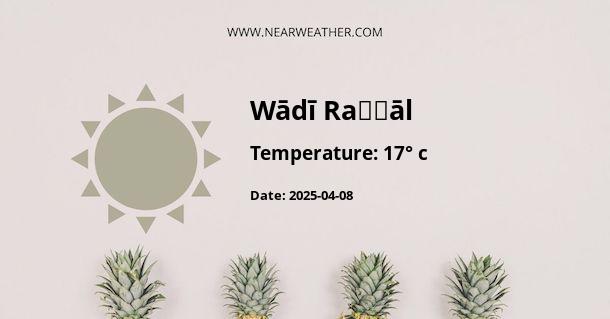Weather in Wadi Rahhal, Palestine
Located in the West Bank region of Palestine, Wadi Rahhal experiences a Mediterranean climate characterized by hot, dry summers and mild, wet winters. The area is known for its diverse topography, ranging from valleys to hillsides, which can create variations in weather patterns within the region. Understanding the year-round climate of Wadi Rahhal is essential for residents, visitors, and businesses operating in the area.
Seasonal Weather Patterns
Let's take a closer look at the seasonal weather patterns in Wadi Rahhal:
Summer (June to August)
Summer in Wadi Rahhal is hot and dry, with temperatures often exceeding 30°C (86°F). The region experiences minimal rainfall during these months, contributing to arid conditions. The average precipitation during this period is less than 1 mm. The hot and dry weather is influenced by the subtropical high-pressure systems that dominate the area.
Autumn (September to November)
Autumn brings a gradual cooling of temperatures in Wadi Rahhal. The weather remains mostly dry, although occasional rainfall may occur. Average temperatures range between 20°C to 25°C (68°F to 77°F) during the day, making it a pleasant time to explore the region's natural beauty.
Winter (December to February)
Wadi Rahhal experiences mild and relatively wet winters. The temperatures often range from 10°C to 15°C (50°F to 59°F) during the day, with nighttime temperatures dropping further. The region receives the majority of its annual precipitation during these months, with an average of 500mm of rainfall throughout the season.
Spring (March to May)
Spring brings a gradual increase in temperatures, with the landscape coming to life as vegetation blooms. Daytime temperatures range from 20°C to 25°C (68°F to 77°F), and the weather remains relatively mild. Precipitation decreases compared to winter, but the occasional rainfall sustains the natural surroundings.
Annual Climate Overview
Here is an overview of the annual climate in Wadi Rahhal:
| Month | Temperature (°C) | Precipitation (mm) |
|---|---|---|
| January | 12°C | 85mm |
| February | 13°C | 80mm |
| March | 15°C | 60mm |
| April | 18°C | 35mm |
| May | 22°C | 15mm |
| June | 25°C | 2mm |
| July | 27°C | 0mm |
| August | 28°C | 0mm |
| September | 26°C | 2mm |
| October | 23°C | 20mm |
| November | 18°C | 45mm |
| December | 14°C | 75mm |
The average annual temperature in Wadi Rahhal is approximately 20°C (68°F), with an average precipitation of 300mm. The contrast between the dry summers and the wetter winters creates a diverse climate that influences the region's flora, fauna, and agricultural activities.
Impact of Weather on Agriculture and Tourism
The climate of Wadi Rahhal plays a significant role in the region's agriculture and tourism industries. The dry summers require efficient water management practices for agricultural activities, while the wet winters support the cultivation of various crops. Additionally, the mild weather during spring and autumn attracts tourists interested in outdoor activities such as hiking, camping, and exploring the natural landscapes.
Agricultural activities in Wadi Rahhal primarily focus on the cultivation of olive groves, vines, and fruit trees, benefiting from the diverse climate that supports different types of produce. The region's unique weather patterns contribute to the cultivation of high-quality agricultural products sought after both domestically and internationally.
Weather Forecasting and Preparedness
Given the distinct seasonal weather patterns in Wadi Rahhal, accurate weather forecasting is essential for both residents and businesses to plan and prepare for the varying conditions. Local meteorological services provide detailed forecasts, including temperature trends, precipitation probabilities, and wind patterns, aiding in decision-making for agricultural practices, outdoor events, and travel plans.
It's crucial for residents and visitors to stay informed about the weather conditions, especially during the transition periods between seasons when rapid weather changes can occur. Being prepared for sudden shifts in weather patterns ensures the safety and well-being of individuals in the region.
Conclusion
The climate of Wadi Rahhal, with its hot, dry summers and mild, wet winters, creates a dynamic and diverse environment that influences various aspects of life in the region. Understanding the seasonal weather patterns and their impact on agriculture, tourism, and daily activities is essential for effective planning and preparation. As Wadi Rahhal continues to thrive amidst its unique climate, the region's resilience and adaptability remain key factors in navigating the ever-changing weather conditions.
A - Wādī Raḩḩāl's Latitude is 31.665159 & Longitude is 35.167271.
A - Weather in Wādī Raḩḩāl is 12° today.
A - Climate Conditions in Wādī Raḩḩāl shows clear sky today.
A - Humidity in Wādī Raḩḩāl is 82% today.
A - Wind speed in Wādī Raḩḩāl is 6.37 km/h, flowing at 327° wind direction. today.
